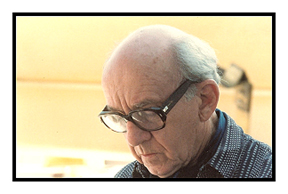
| T H E N I H C A T A L Y S T | M A Y – J U N E 2008 |
|
|
|
H I S T O R YTHE PASSING OF A MUSICAL TRADITION:
|
by
Henry Metzger |
 |
| Giulio Cantoni
|
Forty
years ago at the NIH, the world-famous
ensemble Virtuosi di Roma presented
an all-Vivaldi program to an appreciative crowd of scientists and local
residents.
This was the first of a
series of chamber music concerts initiated by the late NIMH scientist Giulio
Cantoni and supported by the
Foundation for Advanced Education in the Sciences (FAES)—a series that
ended on April 6 this year with a performance by baritone Wolfgang Holzmair and
violinist Russell Ryan.
In those years before the
opening of the John F. Kennedy Center for the Performing Arts in 1971,
world-class chamber music performances were in short supply in the Washington
metropolitan area. Giulio, a native of Italy transplanted to what was then the
sleepy town of Bethesda, had a passion for classical music.
With the help of Paola
Saffiotti in Italy—who represented famous and aspiring musicians and
whose husband, Umberto, had been recruited to the NCI—Giulio set off to
share his passion with the NIH community.
Giulio and Paola’s goal was
to present both well-known artists at the peak of their careers and promising
junior performers. Their first full season, in 1968-1969, included concerts by
such musical luminaries as pianist Mieczyslaw Horszowski, violinist Isaac
Stern, and flutist Jean-Pierre Rampal; over the ensuing seasons the concerts
included outstanding instrumentalists and vocalists from almost every European
country as well as from Japan.
For many performers, the NIH
concerts constituted either their American or Washington debut, and this list
includes Maurizio Pollini (1971), Radu Lapu (1974), Viktoria Mullova (1987) and
Ignat Solzhenitsyn (1992). The concerts were held mostly on Sunday afternoons
in the Clinical Center’s Masur Auditorium.
After the initiation of the
campus security regulations after the events of September 11, 2001, the
concerts had to be moved off campus. This move, as well as a variety of other
factors, led to a gradual but continuing decline in attendance, particularly of
NIH personnel. With the deteriorating financial balance, the concerts required
increasing support from the FAES, further precipitating its demise.
In the last few years as
Giulio’s health deteriorated, Paola had to assume most of the organizational
work—and all of it for the last two seasons after Giulio’s death in July
2006. Paola herself now can no longer keep the series vibrant. It should be
noted that the Cantoni and Saffiotti efforts have been entirely without pay.
The end of the Sunday
afternoon series, albeit a sad passing, does not leave a vacuum of professional
musical offerings at NIH. The Manchester String Quartet presents free concerts
in the Masur Auditorium from 12:30 to 1:30 p.m. on most first Mondays of the
month, October through May.
An unusual feature of the
Manchester Quartet’s popular offering is that it is an integrated series with
detailed program notes; each concert is introduced by informative comments by
the quartet’s leader, cellist Glenn Garlick.
The
Merck Foundation has supported this series, but that support will end after the
completion of its 20th season in 2008–2009. Thereafter, the FAES has
pledged to continue the series. Of course, no series of classical music, often
now simply called “great music,” can survive without an audience. Help keep the NIH hills alive with the
sound of music. ![]()